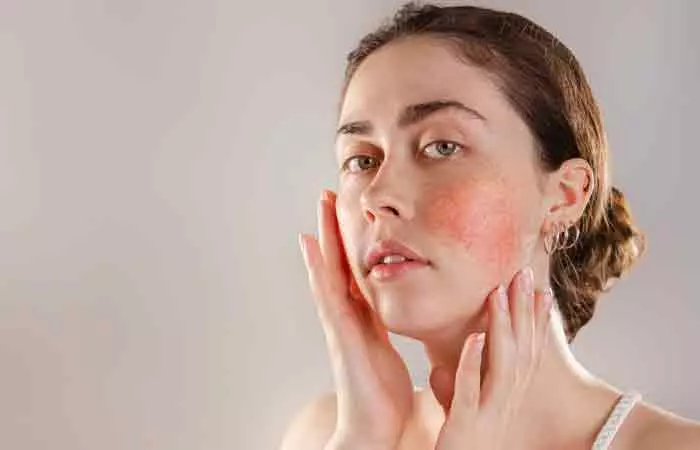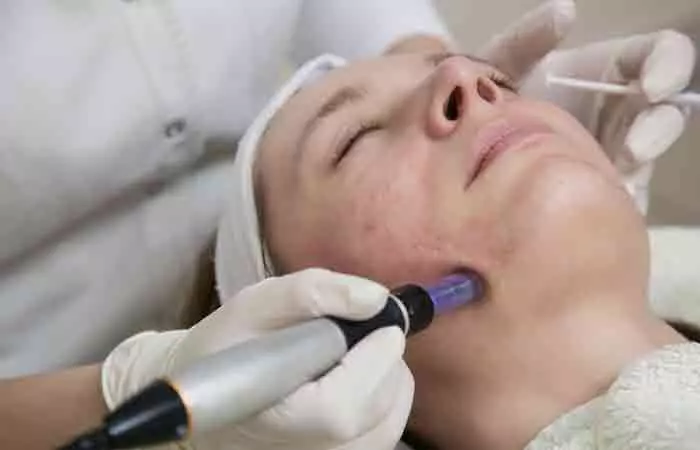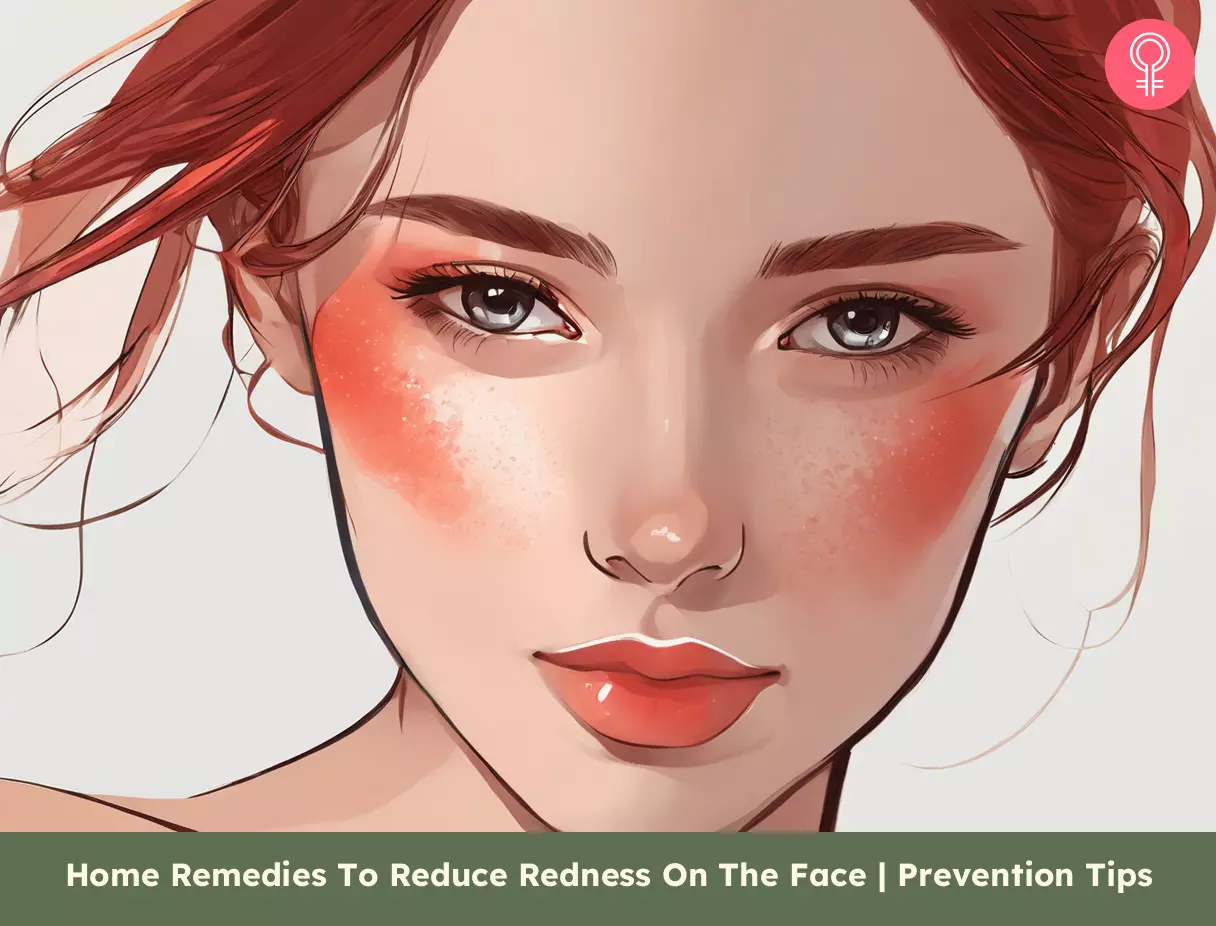What Causes Redness On The Face?
Your face becomes red when the blood vessels dilate, causing more blood to rush to your skin. Redness may be observed not only on your face but also around your neck. This sudden redness of your skin is called flushing or transient redness. It can be a result of long exposure to sunlight, causing sunburn or a strong emotion like anger, embarrassment, stress, or any extreme emotional state. A study conducted on 4,088 adults reported that the neck or the shoulders (66.2%) was the most frequent sunburn location, followed by the face or head (52.6%), arms or hands (40.1%) and back (24.0%). Also, men were more likely to report sunburn on their face or head (54.7%) than women (50.7%). It can also be attributed to other medical reasons, such as menopause and rosacea. Rosacea is a condition that causes the blood vessels under the skin to dilate, making your skin look red. Studies show that the causes of rosacea may be traced back to seborrheai A type of dermatitis that causes red skin and scaly patches on the scalp and in the oily areas of the body. , bacterial infection, Demodexi Tiny parasitic mites living in or around hair follicles and oil-secreting glands of mammals. Also known as eyelash mites or skin and face mites. infestation, etc. (1). Other skin conditions like dermatitis may also cause facial redness. Other factors that cause redness of face are a genetic predisposition to redness of the skin, allergic reaction to certain facial products, exposure to heat or excess sunlight, over-exfoliation of skin, breakouts or acne, and excessive consumption of alcohol (2).
Natural Remedies For Facial Redness
1. Honey
Honey has been used for ages to treat skin conditions and possesses wound healing and anti-inflammatory properties (3). It can help heal any lesions or rashes that may appear on your skin. You Will Need
1 tablespoon of honey Sterile gauze
What You Have To Do
Dab some honey on the sterile gauze. Apply it over the areas where the redness occurs.
How Often You Should Do This Apply honey 3-4 times a day.
2. Aloe Vera
Aloe vera possesses anti-inflammatory and wound healing properties (4). Hence, reduce the red patches that appear on your face and promote faster healing. It also may help lock in skin’s moisture, keeping skin healthy and hydrated. It is also one of the popular home remedies for allergies as it can relieve itching, soothe the skin, and expedite the healing process. You Will Need What You Have To Do How Often You Should Do This Repeat this every night until the redness reduces.
3. Chamomile Tea
Chamomile tea is commonly used to treat skin problems and has anti-inflammatory properties (5). It can help in decreasing inflammation on your skin, which, in turn, reduces redness. You Will Need
Chamomile tea bags A few cups of water
What You Have To Do Repeat this two times daily.
4. Cucumber
Cucumber is great for skin hydration and is a rich source of phytochemicalsi Chemical compounds produced by plants to fight against infections caused by bacteria, fungi and viruses. that reduce the appearance of lesions and acne (6). Hence, it may also help in reducing facial redness. It also leaves the skin looking clearer and moisturized. It can be very calming on the skin too. You Will Need 1 ripe cucumber What You Have To Do How Often You Should Do This You can apply this paste 3-4 times a week.
5. Yogurt
Yogurt contains probiotics. A study showed that oral probiotics could enhance skin barrier function and reduce skin sensitivity (7). This may reduce the appearance of rashes and redness on your face.
2 teaspoons of yogurt 1 teaspoon of lemon juice
What You Have To Do How Often You Should Do This Use this paste two times a week. Note: Lemon can cause allergic reactions in some people. Make sure to carry out a patch test before using this remedy.
6. Green Tea Soak
Green tea contains catechins that exhibit anti-inflammatory and antifungal properties (8). These properties may help reduce the intensity of red patches and irritation, placing it among the popular home remedies for rosacea and other skin disorders. It can be applied on all skin types including sensitive skin. You Will Need
2 teaspoons of green tea leaves Boiled water Clean washcloth
What You Have To Do How Often You Should Do This Repeat this daily until the redness disappears.
7. Petroleum Jelly
Petroleum jelly contains a compound called petrolatum that enhances the skin’s barrier repair function and exhibits antimicrobial properties (9). These properties can help fight any infection that may cause facial redness. You Will Need 1 tablespoon of petroleum jelly What You Have To Do How Often You Should Do This You can repeat this every night until the redness subsides.
8. Lavender Oil
Research shows that lavender oil possesses antifungal, anti-inflammatory, and antimicrobial properties (10). These can help in fighting fungal or bacterial infections that may cause facial inflammation and redness. You Will Need
A carrier oil 2-3 drops of lavender oil
What You Have To Do How Often You Should Do This Do this 2-3 times daily.
9. Coconut Oil
Sometimes, an infection caused by a fungus or bacteria can cause your skin to look inflamed or red. Coconut oil contains lauric acid that exhibits antifungal properties (11). This may help in skin soothing and fight any skin infection that may cause facial redness. You Will Need Virgin coconut oil What You Have To Do How Often You Should Do This Apply coconut oil on the red patches two times a day.
10. Cold Compress
Cold compresses can help soothe inflammation or rashes on your skin, thereby reducing facial redness (12). You Will Need
Ice water A washcloth
What You Have To Do How Often You Should Do This Repeat this two times a day. These were a few home remedies that can be used to reduce the appearance of red patches on your face. We will now discuss the medical treatment options available to treat the redness of the skin.
Medical Treatment Options
If you have red patches on your skin, your dermatologist may suggest the following medications:
Brimonidine tartrate 0.33% gel is a medication that is approved for use in the case of recurrent erythemai A skin reaction causing redness due to inflamed blood capillaries near the skin surface triggered by an infection or medicines. that is associated with rosacea (13). It is known to have a vasoconstrictive effect, which means that it tightens blood vessels in the skin and provides ultimate rosacea relief to reduce the redness on your face. Azelaic acidi A naturally occurring acid in grains (wheat, rye, barley) used as a medicine to treat pimples and acne swelling. has an anti-inflammatory and comedolytici A form of vitamin A medication that prevents the accumulation of oil and skin cells in the pores and helps reduce acne scars. effect on breakouts and acne. This can also reduce the redness on your face. Metronidazole and doxycycline are antibacterial drugs that can kill bacteria on your skin and reduce redness and swelling associated with infections (15), (16).
Lisa R. Marshal, a blogger and a wellness practitioner, shared her experience of using a cream containing benzoyl peroxide to reduce the redness on her face caused by rosacea. She said, “That night I applied the cream to my clean face all over the rash. The following morning it looked and felt less irritated. Within less than a week the entire rash was gone! The redness that had previously been so persistent had faded (i).” These medicines can take a few weeks to a few months to resolve the redness of your skin, depending on the severity. Your doctor may also recommend the following medical procedures to reduce redness of skin or rosacea:
Laser therapy: This procedure employs the use of laser light or intense pulse light to help diminish erythema, thereby reducing the redness of skin (17). Dermabrasion: This procedure involves the use of a wire brush to scrape off or abrade the surface of the skin that is affected (18). However, this method can cause deep cuts, scarring, and, in some cases, permanent color change.
In minor cases, you also may try reducing the redness on your face overnight. Learn more below.
How To Reduce Redness On Face Overnight?
Start by cleansing your face with a mild, non-alcoholic cleanser to remove dirt and impurities. Then apply a cold compress or ice wrapped in a cloth to your face to constrict the blood vessels and reduce inflammation. You may then apply aloe vera gel to the affected areas to soothe the skin. The gel is known for its anti-inflammatory properties (4). Alternatively, you also may place a cooled chamomile tea bag on the red areas for a few minutes for relief (5). Avoid applying any makeup until the redness subsides. Opt for a hypoallergenic, fragrance-free moisturizer to keep your skin hydrated. Lastly, ensure you sleep on a clean pillowcase made of natural fibers like cotton. This helps minimize irritation. But if the redness persists or worsens, consult a dermatologist for proper diagnosis and treatment options. Let us now understand how you can prevent facial redness or flushed skin.
Prevention Tips
Avoid exposure to rapid changes in temperature as this can cause your skin to look flushed. Excessive exposure to sunlight may also cause red patches to appear on the face. Staying hydrated can prevent dehydration and keeps your skin replenished. You should refrain from consuming alcohol regularly as it can cause your skin to look flushed. Practice relaxation techniques, such as meditation, breathing exercises, etc. Sometimes, your skin can appear flushed as a result of stress, trauma, or any other underlying medical condition. If you suspect this is the case, please consult a therapist.
Does toothpaste reduce facial redness? Toothpaste is known to dehydrate pimples, rashes, or boils. This may help reduce redness. However, make sure you consult a dermatologist before you do this. What is the best face wash for redness? If your skin has red patches, you can use herbal facial washes that contain aloe vera extracts to soothe the inflammation. What is the best moisturizer for redness? If your skin shows signs of red spots, rashes, inflammation, irritation, and redness, you can use natural moisturizers that contain aloe vera extracts or cucumber extracts. Does ice reduce facial redness? Yes, ice may help reduce facial redness. You may apply an ice pack or a cold cloth on the affected area for about 15 minutes daily. Which vitamin is good for red skin? Vitamin D has anti-inflammatory properties that may help reduce skin redness caused by sunburn (19). However, consult a doctor before taking oral supplements. How long does facial redness last? Facial redness may last for one or two weeks. Consult a doctor if it lasts longer than that. Does vitamin C help facial redness? It may help. Vitamin C is an antioxidant with anti-inflammatory properties of vitamin C may help reduce temporary redness caused by UV exposure (20).
Illustration: Home Remedies To Reduce Redness On The Face | Prevention Tips
Red cheeks can be caused by a variety of factors. Learn from from a certified dermatologist how to get rid of redness on your cheeks and achieve a healthy, glowing complexion.












